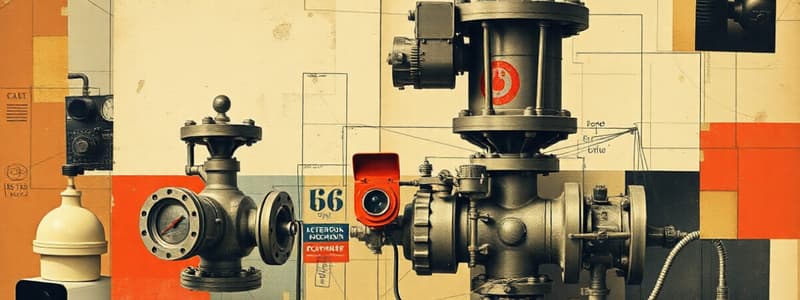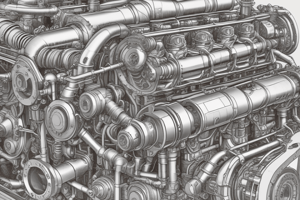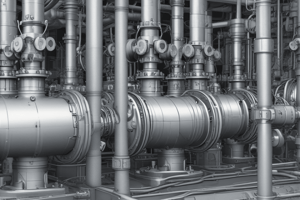Podcast
Questions and Answers
What component of the valve is responsible for providing manual control?
What component of the valve is responsible for providing manual control?
- Stem Link to Positioner
- Handwheel (correct)
- Actuator
- Diaphragm
Which type of valve positioner is indicated for pneumatic valves?
Which type of valve positioner is indicated for pneumatic valves?
- Digital
- Pneumatic (correct)
- Electrical
- Mechanical
What is the function of the actuator in the valve system?
What is the function of the actuator in the valve system?
- To protect the valve from over-pressure
- To provide feedback to the positioner
- To supply air pressure to the system
- To convert electrical signals to mechanical movement (correct)
Which component indicates the position of the valve?
Which component indicates the position of the valve?
What additional feature is often included with solenoid valves for backup?
What additional feature is often included with solenoid valves for backup?
Which valve type is designed specifically to control the direction of air flow in a pneumatic system?
Which valve type is designed specifically to control the direction of air flow in a pneumatic system?
What is the primary function of a pressure relief valve in a pneumatic system?
What is the primary function of a pressure relief valve in a pneumatic system?
Which component in a pneumatic valve provides restoring force to return the valve to its closed position?
Which component in a pneumatic valve provides restoring force to return the valve to its closed position?
In what scenario would a proportional valve be most beneficial?
In what scenario would a proportional valve be most beneficial?
What is the primary operating principle behind pneumatic valves?
What is the primary operating principle behind pneumatic valves?
Which type of pneumatic valve typically has a simpler design and is adequate for simple binary control?
Which type of pneumatic valve typically has a simpler design and is adequate for simple binary control?
What component is responsible for preventing leakage in pneumatic valves?
What component is responsible for preventing leakage in pneumatic valves?
What is the main role of the valve seat in a pneumatic system?
What is the main role of the valve seat in a pneumatic system?
When selecting materials for pneumatic valve components, which factor is NOT typically considered?
When selecting materials for pneumatic valve components, which factor is NOT typically considered?
Which component links the actuator to the valve closure mechanism?
Which component links the actuator to the valve closure mechanism?
What factor is essential for valve sizing and selection?
What factor is essential for valve sizing and selection?
What is the purpose of regular lubrication during valve maintenance?
What is the purpose of regular lubrication during valve maintenance?
What is the most common cause of a valve being stuck in the open position?
What is the most common cause of a valve being stuck in the open position?
When assessing for leaks, which components should be primarily checked?
When assessing for leaks, which components should be primarily checked?
Which issue is commonly associated with low output from a valve?
Which issue is commonly associated with low output from a valve?
Which maintenance task is critical for ensuring the reliability of a valve?
Which maintenance task is critical for ensuring the reliability of a valve?
What is a likely cause of abnormal noises coming from the valve?
What is a likely cause of abnormal noises coming from the valve?
What could a malfunctioning spring system in a valve lead to?
What could a malfunctioning spring system in a valve lead to?
Which signal issue would likely lead to incorrect valve operation?
Which signal issue would likely lead to incorrect valve operation?
What is an important troubleshooting measure for calibration issues?
What is an important troubleshooting measure for calibration issues?
Flashcards
Valve Components
Valve Components
A valve is made up of various parts like a handwheel, diaphragm, spring, I/P transducer, and stem, among others, each with a specific function.
Valve Types (Positioner)
Valve Types (Positioner)
Different valves can be controlled by electrical, pneumatic, or hydraulic positioners. Each uses a different method to control the valve's position.
Valve Positioner
Valve Positioner
The valve positioner is a device that controls the valve's movement based on input signals from a controller.
Electrical Positioner
Electrical Positioner
Signup and view all the flashcards
Pneumatic Positioner
Pneumatic Positioner
Signup and view all the flashcards
Pneumatic Valve
Pneumatic Valve
Signup and view all the flashcards
Valve Body
Valve Body
Signup and view all the flashcards
Valve Stem
Valve Stem
Signup and view all the flashcards
Valve Seat
Valve Seat
Signup and view all the flashcards
Actuator
Actuator
Signup and view all the flashcards
Directional Control Valve
Directional Control Valve
Signup and view all the flashcards
On/Off Valve
On/Off Valve
Signup and view all the flashcards
Proportional Valve
Proportional Valve
Signup and view all the flashcards
Pressure Relief Valve
Pressure Relief Valve
Signup and view all the flashcards
Check Valve
Check Valve
Signup and view all the flashcards
Flow Regulation by Valves
Flow Regulation by Valves
Signup and view all the flashcards
Valve Sizing Importance
Valve Sizing Importance
Signup and view all the flashcards
What is Valve Maintenance?
What is Valve Maintenance?
Signup and view all the flashcards
Valve Inspection
Valve Inspection
Signup and view all the flashcards
Valve Lubrication
Valve Lubrication
Signup and view all the flashcards
Valve Cleaning
Valve Cleaning
Signup and view all the flashcards
Valve Stuck Open/Closed
Valve Stuck Open/Closed
Signup and view all the flashcards
Abnormal Valve Noises
Abnormal Valve Noises
Signup and view all the flashcards
Low Valve Output
Low Valve Output
Signup and view all the flashcards
Study Notes
Valve Positioner Components
- A valve positioner receives a control signal and adjusts air pressure to move the valve stem
- The input signal comes from a controller
- Output signal from the valve positioner controls the valve
- Air supply pressure provides the power to move the valve stem
- Valve positioner is a component that precisely adjusts the valve position based on input signals, using regulated air pressure
- Grease fitting is a part to make the movement smooth
- Internal components include a diaphragm, spring, and I/P transducer
- A mechanical linkage connects the stem to a positioner
- Stem interacts with valve and packing devices, which are maintained
- The plug seals the valve
- The bonnet is the valve's outer casing
- Valve positioners have various types such as pneumatic, electronic, and digital
Valve Positioner Function
- Valve positioners translate a signal from a controller into an output, which activates the valve
- The controlled output is the level of air pressure acting on the valve
- Ensures the valve operates with accuracy and precision
- The control loop is self-containing by design
Valve Positioner Type
- Electrical: using electricity to activate
- Pneumatic: using air pressure to activate
- Digital: using electronic digital signals to activate
- Hydraulic: may use hydraulics
- Electronic: uses electronic signals to control position
Additional Protective Components
- Solenoid added for protection/backup
- 3 -way temp control service is for protection against high temperature
Studying That Suits You
Use AI to generate personalized quizzes and flashcards to suit your learning preferences.




